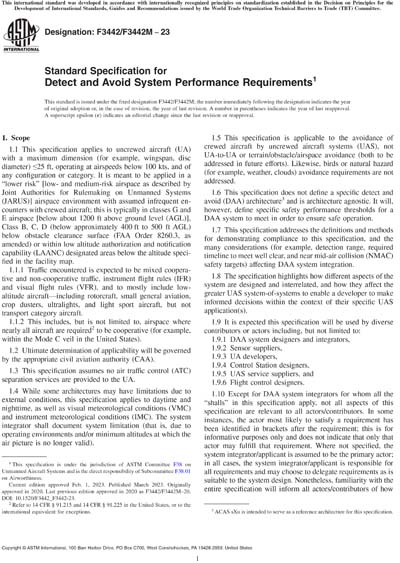Most recent
ASTM F3442/F3442M-23
Standard Specification for Detect and Avoid System Performance Requirements
1.1This specification applies to uncrewed aircraft (UA) with a maximum dimension (for example, wingspan, disc diameter) ‰¤25 ft, operating at airspeeds below 100 kts, and of any configuration or category. It is meant to be applied in a "lower risk" [low- and medium-risk airspace as described by Joint Authorities for Rulemaking on Unmanned Systems (JARUS)] airspace environment with assumed infrequent encounters with crewed aircraft; this is typically in classes G and E airspace [below about 1200 ft above ground level (AGL)], Class B, C, D (below approximately 400 ft to 500 ft AGL) below obstacle clearance surface (FAA Order 8260.3, as amended) or within low altitude authorization and notification capability (LAANC) designated areas below the altitude specified in the facility map.
1.1.1Traffic encountered is expected to be mixed cooperative and non-cooperative traffic, instrument flight rules (IFR) and visual flight rules (VFR), and to mostly include low-altitude aircraft - including rotorcraft, small general aviation, crop dusters, ultralights, and light sport aircraft, but not transport category aircraft.
1.1.2This includes, but is not limited to, airspace where nearly all aircraft are required2 to be cooperative (for example, within the Mode C veil in the United States).
1.2Ultimate determination of applicability will be governed by the appropriate civil aviation authority (CAA).
1.3This specification assumes no air traffic control (ATC) separation services are provided to the UA.
1.4While some architectures may have limitations due to external conditions, this specification applies to daytime and nighttime, as well as visual meteorological conditions (VMC) and instrument meteorological conditions (IMC). The system integrator shall document system limitation (that is, due to operating environments and/or minimum altitudes at which the air picture is no longer valid).
1.5This specification is applicable to the avoidance of crewed aircraft by uncrewed aircraft systems (UAS), not UA-to-UA or terrain/obstacle/airspace avoidance (both to be addressed in future efforts). Likewise, birds or natural hazard (for example, weather, clouds) avoidance requirements are not addressed.
1.6This specification does not define a specific detect and avoid (DAA) architecture3 and is architecture agnostic. It will, however, define specific safety performance thresholds for a DAA system to meet in order to ensure safe operation.
1.7This specification addresses the definitions and methods for demonstrating compliance to this specification, and the many considerations (for example, detection range, required timeline to meet well clear, and near mid-air collision (NMAC) safety targets) affecting DAA system integration.
1.8The specification highlights how different aspects of the system are designed and interrelated, and how they affect the greater UAS system-of-systems to enable a developer to make informed decisions within the context of their specific UAS application(s).
1.9It is expected this specification will be used by diverse contributors or actors including, but not limited to:
1.9.1DAA system designers and integrators,
1.9.2Sensor suppliers,
1.9.3UA developers,
1.9.4Control Station designers,
1.9.5UAS service suppliers, and
1.9.6Flight control designers.
1.10Except for DAA system integrators for whom all the "shalls" in this specification apply, not all aspects of this specification are relevant to all actors/contributors. In some instances, the actor most likely to satisfy a requirement has been identified in brackets after the requirement; this is for informative purposes only and does not indicate that only that actor may fulfill that requirement. Where not specified, the system integrator/applicant is assumed to be the primary actor; in all cases, the system integrator/applicant is responsible for all requirements and may choose to delegate requirements as is suitable to the system design. Nonetheless, familiarity with the entire specification will inform all actors/contributors of how their contributions affect the overall DAA capability and is strongly recommended.
1.11The values stated in either SI units or inch-pound units are to be regarded separately as standard. The values stated in each system are not necessarily exact equivalents; therefore, to ensure conformance with the standard, each system shall be used independently of the other, and values from the two systems shall not be combined.
1.12This standard does not purport to address all of the safety concerns, if any, associated with its use. It is the responsibility of the user of this standard to establish appropriate safety, health, and environmental practices and determine the applicability of regulatory limitations prior to use.
1.13This international standard was developed in accordance with internationally recognized principles on standardization established in the Decision on Principles for the Development of International Standards, Guides and Recommendations issued by the World Trade Organization Technical Barriers to Trade (TBT) Committee.
ASTM International [astm]

